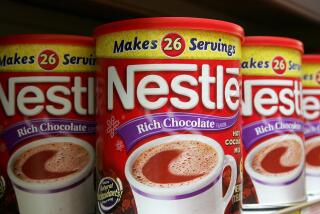From Tree to Heart-Shaped Box
- Share via
With less than a week until Valentine’s Day, romantics everywhere are snapping up chocolates, especially the ones in cute heart-shaped boxes.
Chocolate lovers have the Maya Indians of Central America and the Aztec Indians of Mexico to thank for the early cultivation of the cacao bean, from which chocolate is made. The Aztecs believed that one of their prophets had brought the seeds from paradise.
Today, people have different things in mind when they choose chocolate, especially around Valentine’s Day.
“Chocolate is an aphrodisiac and it makes you feel good,” said Frank Sheftel, owner of the Candy Factory in North Hollywood. “Flowers wilt and die, but chocolate will last forever. Once you eat it, it’s on your hips!”
In fact, a 1.4-ounce milk chocolate bar has 12.6 grams of fat, which is nearly one-fifth of an adult’s recommended daily fat allowance. While generally high in fat, chocolate has less caffeine than one might expect: An ounce of milk chocolate contains about 6 milligrams of caffeine, about the same amount as a cup of decaf coffee.
If you just can’t pass up indulging in some Valentine’s Day chocolate, the American Dietetic Assn. suggests you choose low-fat foods at other meals during the day.
From Tree to Heart-Shaped Box
1. Pods are cut from the cacao tree and opened to reveal the 20 to 40 almond-shaped seeds that will eventually become cocoa beans. The cacao tree’s beans became known as cocoa beans in English-speaking countries due to a mistake made many years ago, probably by English importers.
2. The beans are placed in piles on the ground or in boxes or baskets, covered with banana leaves or burlap and allowed to ferment for approximately a week to reduce bitterness.
3. To prevent molding, the beans are dried in the sun or with artificial heat before being placed in large burlap bags for shipment.
4. Processing begins by cleaning the beans using screens and air currents to remove extraneous material.
5. The beans are then roasted by forcing hot air through rotating cylinders. Roasting develops flavor and aroma and loosens the shells.
6. After cooling, the beans are cracked and the shells are removed, a process called winnowing.
7. The remaining particles, called nibs, are then ground into a liquid form, from which cocoa powder and cocoa butter are derived.
8. For milk chocolate, the liquid is mixed with powdered milk and pulverized sugar or with a mixture of milk and dissolved sugar. For sweet chocolate, also known as dark chocolate, and semi-sweet chocolate, the liquid is mixed with pulverized sugar. Baking or unsweetened chocolate is simply solidified raw chocolate.
9. After blending, the chocolate is ground by steel roll refiners to make it smoother.
10. Cocoa butter is added to convert the fine powder into a paste. Spices or flavorings are usually added at this point.
11. Machines called conches stir the chocolate for up to 72 hours to help develop its flavor and make it smooth enough to place for molding. The chocolate is then prepared for molding by a process known as tempering.
12. The chocolate is molded into blocks, bars or other shapes. It is wrapped, packaged and shipped to stores.
Chocolate Trivia
* Calories and fat content range from 50 calories and less than 1 gram of fat for a tablespoon of cocoa to 150 calories and 16 grams of fat for 1 ounce of baking chocolate.
* Most chocolate has 2 to 3 grams of protein per ounce.
* A 1.4-ounce piece of chocolate can have anywhere from 2 to 23 milligrams of caffeine, depending on how it’s made.
* Children get only about 1.5% of their total caffeine intake from chocolate.
* The largest chocolate model--in the shape of a traditional Spanish sailing ship--weighed 4.4 tons. It was made by a cooking school in Barcelona in February 1991.
Sources: Chocolate Manufacturers Assn. of the USA; American Dietetic Assn.; Institute of Food Technologists; World Book; the Guinness Book of World Records; Nestle USA; Dove International. Researched by STEPHANIE STASSEL/Los Angeles Times.
More to Read
Eat your way across L.A.
Get our weekly Tasting Notes newsletter for reviews, news and more.
You may occasionally receive promotional content from the Los Angeles Times.










